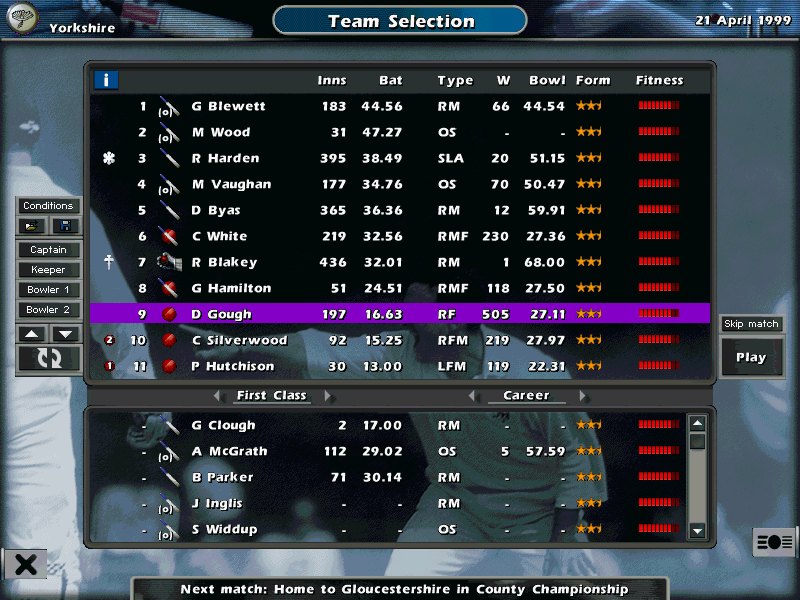
International Cricket Captain 2
Written by: Rik
Date posted: June 13, 2005
- Genre: Sport
- Developed by: Empire Interactive
- Published by: Empire Interactive
- Year released: 1999
- Our score: 6
Some of you might recall an old football management game called Premier Manager. To be honest, it was pretty rubbish but people were happy enough to play it seeing as the Championship Manager phenomenon had yet to take off. However, there were a couple of things about it which caused people to feel a little miffed; one was the requirement that you, as manager, had to find sponsors for each and every advertising hoarding at the ground (a tedious and time consuming process which probably doesn’t – we’re guessing – figure highly on Jose Mourinho’s list of priorities). The other was the fact that, despite having the word Premier in the title, you couldn’t actually begin the game at a Premiership club and instead had to work your way up from the non-league world as manager of Wycombe Wanderers (or whoever else was in the Conference circa 1992/3).
Then a few years later we got International Cricket Captain, a game which also boasted a number of irritating idiosyncrasies (the inability to bowl around the wicket was a particularly significant oversight) and had a sneakily misleading title. You see, in cricket, like many sports, the captain plays in the match along with the rest of the team, but in ICC you don’t. So, for those of you not already put off by a game with the word “cricket” in the title but who may have hoped for some amusing fun trying to smash every ball out of the ground or attempting to hit the batsman on the head, let’s make this clear: in ICC you have no control over the action itself – you just watch.
In fairness, the roles of captain and coach in cricket are a little more complicated than in, say, football, where the manager calls all the shots and the captain is merely a glorified cheerleader who gets to wear an armband and run out of the tunnel first. In cricket, the coach and management still make the important off-field decisions with regard to new signings and team selection, but once the team is on the pitch, then the captain is virtually in control of his team’s fortunes – choosing whether to bat or bowl first, setting the field, changing the bowling, timing a declaration and so on. In ICC you get the best of both worlds – making all the decisions both on and off the pitch, effectively making you some kind of cricket overlord. But then International Cricket Overlord probably wouldn’t make a very good name for a series of cricket games. And while we’re griping at the title, we may as well point out that while international cricket is a part of ICC (and you can captain England if you so wish), it’s really more geared around the significantly less glamorous world of domestic county cricket.
While these points apply to the series as a whole, it probably should be pointed out that it’s the sequel we’re concerned with here, partly because, ahem, it’s the version I happen to own, but also because it irons out many of the original’s faults, oversights and programming bugs to make it a significantly more enjoyable experience. Since ICC2 was released, there have been numerous other annual updates, none of which represent such a radical overhaul of the basic engine, although they do of course provide updated teams and statistics. Depending on how much these things matter to you, you might want to seek out a newer version than this, although personally it’s never really bothered me. In any case, ICC2 is the earliest version you should consider.
As we’ve pointed out already, ICC2 is a cricket management game, in which you attempt to guide your chosen county to glory in a variety of competitions – the four-day County Championship, the one-day National League and the knockout Natwest Trophy. Success is achieved by bringing the right combination of players into the squad during the off-season and then making the right tactical decisions on the pitch. As with many other sports management games, the size of your task depends on the initial strength of your chosen team, particularly as new signings can only be brought in at the end of each season. Take control of Yorkshire, for example, and you’d find a strong side, particularly on the bowling front, perhaps only a quality batsman or two away from a Championship-winning side. Captaining a weaker team such as Derbyshire would be a considerably more frustrating experience, relying heavily on a couple of star players while fruitlessly rotating a host of others who suffer from a basic lack of ability.
With thoughts of any ins and outs best put to the back of your mind until the end of your first season, you have to find a way to get the best out of what you’ve already got. ICC2 isn’t the most stat-heavy game ever, though, and those without a prior knowledge of the county game will struggle to immediately identify their strongest line-up. The best clue is to compare the players’ averages, although this doesn’t particularly help with the younger players in the squad. However, it should quickly become obvious who your key players are, and the selection of the basis of your side should be pretty straightforward. A couple of positions may well be contested, however, and it’s here where you’ll start to make important decisions. Overcast conditions may suit an extra pace bowler, for example, or a spinner may be useful if the pitch is likely to deteriorate as the match wears on. Aside from this of course, a well-balanced side is always important, and it’s possible to compensate for a perceived weakness in batting or bowling by bolstering that part of your side – as long as the other doesn’t suffer as a result.
The match itself is the most involving part of the game. While picking the right team is obviously a good start, you really need to make the right decisions on the pitch to be a success. Making the right decision at the toss involves a variety of factors, including the weather, the state of the pitch and the makeup and relative strengths of the two sides. Once you get onto the pitch, you exert a great deal of control over your individual players. In the field, you need to decide how aggressively you want your bowlers to bowl, as well as the kind of line they should attack. Opposition batsmen all have a range of preferences in their profile (for a particular type of bowling or a particular area where they like to hit the ball) and this gives you a clue as to how you should ask your bowlers to bowl at them. When batting, things are a little more straightforward; you merely set the aggression level of your batsmen (indicated by the number of runs they should try and score per over) and this may be varied against different types of bowler, according to each batsman’s skill level and preferences, as well as the match situation.
When you’re not managing your team you can watch their progress in the match via some rather rudimentary action sequences. While they’re not exactly state-of-the-art, it has to be said they have a certain charm: the various bowling and batting animations aren’t unrealistic, and there’s even the BBC cricket correspondent, Jonathan Agnew, on hand to provide some commentary. It has to be said, however, that watching every ball of the match played out this way would test the patience of even the most ardent cricket fan, and most will probably opt for the highlights (a wicket, a boundary, or a near-miss) of each over. If anything this makes the game more involving – whenever the action screen occurs you find yourself tensing up in the knowledge that something significant is about to happen.
Playing ICC2 can be a rewarding and satisfying experience, even for non-cricket buffs. Compared with, say, Championship Manager, it’s relatively undemanding, it’s not loaded with statistics, and the action highlights inject some excitement into proceedings. Cricket fans, on the other hand, will instantly recognise the extent to which the game mirrors the ups and downs of the real-life sport: that feeling of helplessness when (particularly in a one-day game) your bowlers are getting smashed to all parts, or that feeling of joy when it all comes together and you pull off an unlikely victory.
For some, however, the lack of detail in ICC2 is ultimately its shortcoming. Between matches there is little to do other than allocate coaching sessions to your struggling players; there is virtually no detail of how players not currently in the first team are progressing (aside from some vague and occasionally statistically anomalous second-team statistics); and the hit-and-miss nature of bringing through young players means that as the game progresses and more familiar names retire the game starts to lose its appeal.
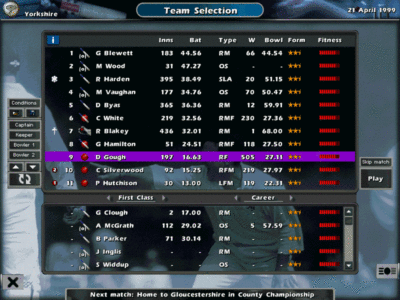
Selecting the Yorkshire team used to be a case of which international-class pace bowler to leave out…[sigh]
What all of this means is that while ICC2 may not have the long-term appeal of a Championship Manager, it possesses a sufficient amount of detail to appease cricket fans while at the same time being accessible enough to appeal to the rest of the gaming world – now if you could just get over the fact that it’s a cricket management game…

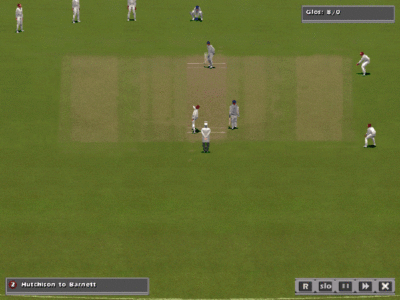
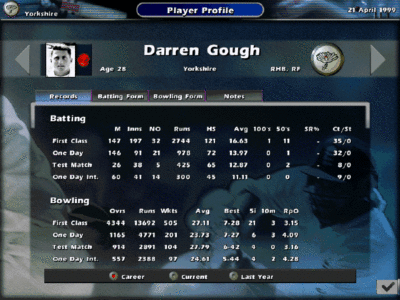
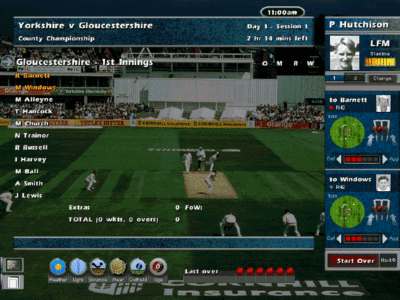

 Posts
Posts